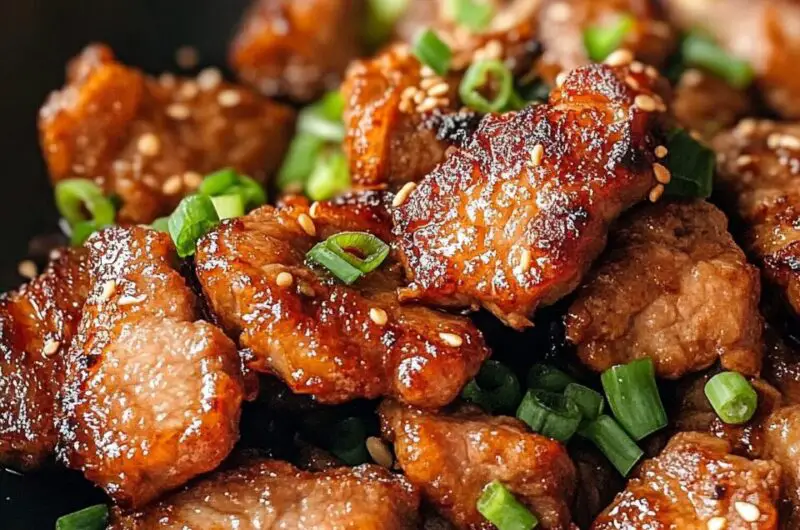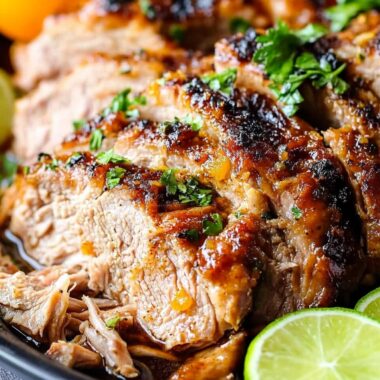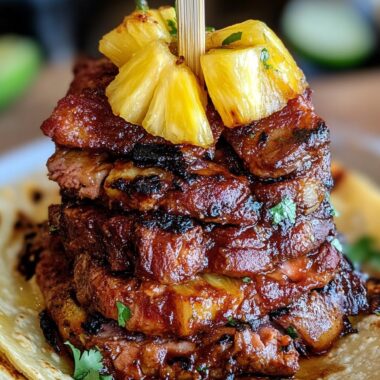The savory aroma of these Cantonese-style Salt and Pepper Pork Chops will instantly transport you to your favorite Chinese restaurant. Tender slices of pork are marinated, coated in a light, crunchy crust, then tossed with sizzling garlic, scallions, and chili for an unforgettable flavor. This dish is the perfect fusion of comfort food and authentic Asian flavor. It’s easy to prepare and perfect for both weeknight dinners and casual gatherings. Pair it with jasmine rice or a crisp cucumber salad for a well-rounded meal that delivers on both crunch and spice.
Full Recipe:
Ingredients:
-
4 boneless pork chops (about 1/2 inch thick)
-
1 tablespoon Shaoxing wine
-
1 tablespoon soy sauce
-
1/2 teaspoon sugar
-
1/4 teaspoon ground white pepper
-
1/4 teaspoon salt
-
1/4 cup cornstarch
-
1/4 cup potato starch
-
Oil for frying
For Aromatics:
-
3 cloves garlic, finely minced
-
1 jalapeño or green chili, thinly sliced
-
2 scallions, chopped
-
1/2 teaspoon ground Sichuan peppercorn (optional)
Directions:
-
Pat pork chops dry and cut into bite-sized strips. In a bowl, marinate with Shaoxing wine, soy sauce, sugar, white pepper, and salt. Let sit for 15–20 minutes.
-
In a separate bowl, mix cornstarch and potato starch. Dredge marinated pork in the starch mixture, coating well.
-
Heat 2 inches of oil in a deep skillet or wok over medium-high heat (about 350°F / 175°C).
-
Fry pork in batches until golden brown and crispy, about 4–5 minutes. Drain on a wire rack or paper towel.
-
In a clean pan, heat 1 tablespoon oil over medium heat. Add garlic, chili, and scallions, stir-frying until fragrant (about 30 seconds).
-
Add the fried pork back in, toss quickly to coat in the aromatics. Sprinkle with Sichuan peppercorn if using. Serve hot.
Prep Time: 20 minutes | Cooking Time: 15 minutes | Total Time: 35 minutes
Kcal: 410 kcal | Servings: 4 servings
The Allure of Salt and Pepper Pork Chops: A Cantonese Classic
Few dishes embody the essence of Chinese home-cooking as deliciously and simply as Salt and Pepper Pork Chops. Originating from the heart of Cantonese cuisine, this dish delivers a powerful punch of flavor through a deceptively simple combination of ingredients. Juicy pork, aromatic garlic, and zesty green chili come together in a dish that is crisp on the outside, tender inside, and impossible to resist.
Whether you’re exploring Chinese cuisine for the first time or a seasoned home cook looking for a reliable dinner favorite, this dish captures everything you could want from a comfort food recipe: quick prep, accessible ingredients, and satisfying results.
A Taste of Cantonese Cooking
Salt and Pepper Pork Chops are a cornerstone of Cantonese-style cooking, which emphasizes light seasoning, fresh ingredients, and balanced flavors. Unlike some other regional Chinese cuisines that lean heavily on chili pastes or fermented sauces, Cantonese food typically seeks to let the natural flavor of the meat shine through, enhanced with subtle aromatics.
This dish likely began in Hong Kong or southern China, where quick stir-frying techniques and deep frying were commonly used in both homes and dai pai dong (open-air food stalls). The preparation method offers a crunchy texture paired with just the right amount of seasoning enough to tickle the taste buds without overwhelming them.
In many Chinese restaurants abroad, especially those serving Hong Kong-style or “Chop Suey” style food, Salt and Pepper Pork Chops have become a menu staple, celebrated for both their flavor and eye-catching appearance.
The Secret Behind the Crunch
At the heart of this dish’s appeal is the perfectly crispy exterior. Achieving this texture is not just about frying it’s about technique and ingredient choice.
The pork is first marinated with soy sauce, Shaoxing wine, sugar, and white pepper, giving it a delicate savory note and tenderizing the meat. What makes it truly special, however, is the use of a dual starch coating, usually a mix of cornstarch and potato starch. This combination provides a balance between a light crunch (from the cornstarch) and a slightly chewy, resilient coating (from the potato starch), resulting in that signature shatteringly crisp crust.
The pork is fried until golden brown and then tossed in hot oil again after a rest period a technique known as double frying, which further enhances the crispiness and ensures the meat stays tender inside.
A Flavor Profile That Balances Heat and Umami
While the title may suggest a simplistic seasoning of just salt and pepper, the flavor complexity of this dish lies in the balance between spice, umami, and aromatics.
The classic version includes:
-
Garlic: Adds depth and an earthy sharpness.
-
Green chili or jalapeño: Offers a gentle heat that doesn’t overpower the other ingredients.
-
Scallions: Provide freshness and slight sweetness.
-
Sichuan peppercorns (optional): Bring a floral, tongue-tingling element that elevates the flavor.
It’s the interplay of these ingredients that creates an almost addictive quality you keep going back for another bite because no two are exactly the same. Some have more garlic, some pack extra chili heat, and others bring that peppery zip that makes this dish unforgettable.
Common Variations Across Regions
One of the joys of Salt and Pepper Pork Chops is its adaptability. Here are a few popular variations:
-
Sichuan Style: Incorporates dry red chilies and Sichuan peppercorns for a numbing spiciness.
-
Taiwanese Take: Adds five-spice powder or uses pork ribs instead of chops.
-
Western Fusion: Some chefs incorporate panko breadcrumbs or add a light soy glaze to cater to Western palates.
-
Vegetarian Version: Substitute pork with tofu, seitan, or cauliflower for a plant-based adaptation that still honors the original seasoning.
Some cooks even swap pork for shrimp, squid, or chicken wings to apply the same method to different proteins.
What to Serve With Salt and Pepper Pork Chops
This dish pairs well with a variety of sides, but to balance its bold flavors and crispy texture, consider these complementary options:
-
Steamed Jasmine or Basmati Rice: A neutral canvas to soak up the seasoning.
-
Stir-Fried Greens: Bok choy, gai lan (Chinese broccoli), or spinach tossed with garlic balances the richness.
-
Simple Cucumber Salad: Fresh, crisp, and slightly acidic, helping to cleanse the palate.
-
Egg Drop or Hot and Sour Soup: Adds another textural and temperature contrast.
The beauty of this dish is how well it fits into a larger family-style meal, surrounded by lighter or saucier dishes that highlight the contrast.
Cooking Tips from the Experts
If you’re attempting Salt and Pepper Pork Chops at home for the first time, here are a few expert tips to get it just right:
-
Pat Dry Before Coating: This helps the starch adhere better and promotes crispiness.
-
Don’t Crowd the Pan: Fry the pork in batches to maintain oil temperature and avoid sogginess.
-
Use Fresh Oil: Old or overused oil can impart bitterness and a dark color.
-
Customize Your Aromatics: Add minced ginger or a splash of rice vinegar if you prefer a tangier note.
-
Rest After First Fry: Letting the pork sit for 5–10 minutes between fries enhances crispness.
Why This Recipe Belongs in Your Kitchen
From its roots in Hong Kong street food culture to its spot on the menus of upscale Chinese restaurants, Salt and Pepper Pork Chops exemplify why some dishes become timeless. They are:
-
Flavor-packed yet minimal in preparation.
-
Customizable to suit spice tolerance and dietary preferences.
-
Crispy, juicy, and bold the ultimate trifecta.
-
Family-friendly and ideal for both everyday meals and weekend feasts.
Whether you’re cooking for yourself, your family, or to impress guests, this recipe offers maximum reward for a modest amount of effort.
Conclusion:
Salt and Pepper Pork Chops aren’t just a meal they’re a culinary experience. From the sizzling of the pork in hot oil to the fragrant aroma of garlic and chili wafting through your kitchen, every step draws you closer to a meal that satisfies deeply.
In a world of complex recipes and endless options, this Cantonese classic reminds us that sometimes the simplest combinations are the most enduring. Once you master it, you’ll find yourself coming back to this recipe again and again not because you have to, but because you want to.








